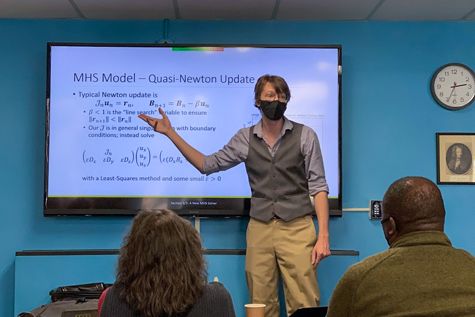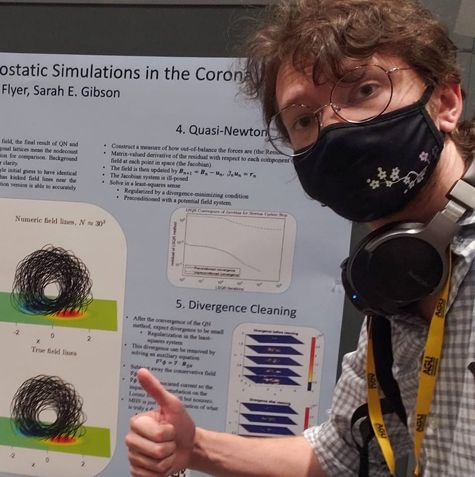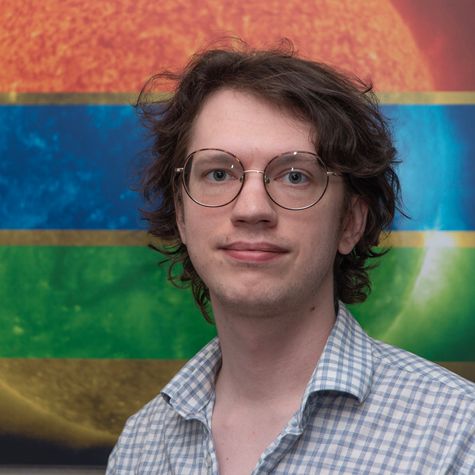Early Career Scientist Spotlight
Dr. Nat Mathews
Computational Mathematician
Solar Physics Laboratory (671)
What science questions do you investigate?
My research investigates space weather events, and whether we can predict them before they occur. Space weather has the potential to affect us every day; we see it in the auroras, but it can also impact satellite launches, telecommunications and even the safety of astronauts. In order to predict some of the most violent space weather events – Coronal Mass Ejections – we have to have a good idea of what the Sun is doing right now. My work is part of an effort to model the current state of those coronal magnetic fields before they erupt. There are many open questions revolving around what kinds of observations such a reconstruction would require, and what computational resources would have to be dedicated to the task, and how the pipeline would have to be structured.
Did you always know that you wanted to study magnetic fields in the Sun?
Sort of. I’ve always been interested in astronomy. I grew up looking through telescopes at the stars, and I did some work on gravitational waves during my undergraduate degree in Rochester, NY. However, I didn’t define my research focus until my graduate studies. My main research focus is actually on Inverse Problems – the sorts of mathematical questions that aim to determine what is happening inside of a system based on external observations. Especially in fields with complicated physics, these are among the most difficult problems in science. In graduate school, I encountered solar physics from that perspective, as just another mathematical question. We want to know what the magnetic field is like inside the Sun, but it is impossible to go in and measure it. In working on that problem, I fell in love with solar physics.

Credit: Mat Heck
Tell us about one project of yours that has been particularly impactful in your field.
I worked with scientists at the High Altitude Observatory in Boulder, Colorado on something called the Data-Optimized Coronal Field Model. You can read about my work on this topic. The idea is that you can use observations of the solar atmosphere in polarized light to constrain and update magnetic field models with an automated optimization algorithm. The method produces many hundreds of magnetic fields of the type that can exist in the solar corona based on observations of the solar surface. It then extrapolates what such a structure would look like if it were viewed from the side with a coronographic imager in polarized light. We can compare all of these models with the true observations, and create new magnetic models iteratively to best match the observations we have.
If you were to expand your current research focus, what new topics would you explore?
Right now, I’m working on modeling and extrapolating the magnetic fields in the solar corona – above the surface of the Sun. It’s much harder to measure the Sun’s behavior below the surface. But those fields are just as important in trying to figure out what the Sun will do in the future and why. If I were to expand my research focus, I would try to aid efforts to use seismic observations to try to understand what’s happening deep in the Sun.

Credit: Nat Mathews
What is one research project that you are particularly excited about, and why?
The project I’m most excited about at the moment is a Physics-Informed Neural Network representation of the solar corona. The sticking point with the old Data-Optimized Coronal Field Model approach was that it was too slow to make realistic models of active regions of the Sun in nearly-real time. In practice, hundreds of thousands of magnetic models have to be constructed as part of the optimization search. Each magnetic model is a full simulation in its own right, making the search simply infeasible with current computational resources.
The hope is that we can approximate the computationally expensive parts of the search method with Machine Learning. We are training a machine-learning algorithm to quickly produce approximations of magnetic field models. In this way, we hope we will be able to build realistic models of the Sun much more quickly.
What keeps you inspired by your work?
Doing good science is about building tools to help people. Researchers all over the world are trying to improve space weather forecasts, to help the real people who can be impacted by coronal mass ejections. The motivation of my work is to help those researchers, giving them better tools to progress their own studies. It’s a little like forging a hammer or saw, knowing that a carpenter will use it to make furniture to improve peoples’ lives. It can be harder to see the progress in science – day to day, it’s hard to know if that hammer will ever be done. But every day is a step towards finishing it.

Credit: Hannah Mathews
What do you like to do in your free time?
I like to play music, and I like to hang out in nature. Music-wise, I play mostly piano and mandolin, but I dabble in bouzouki, ukulele and banjo, among other instruments. Outdoors, I do a lot of hiking. I have had the opportunity to hike in Scotland, the Rockies, the northeastern US, and in the Pacific, backpacking and bouldering.
Biography
Home Town:
Hadley, Massachusetts
Undergraduate Degree:
B.S. Computational Mathematics, Rochester Institute of Technology, Rochester NY
Post-graduate Degrees:
Ph.D. Applied Mathematics, University of Colorado Boulder, Boulder CO

Link to Dr. Mathews's GSFC Bio
